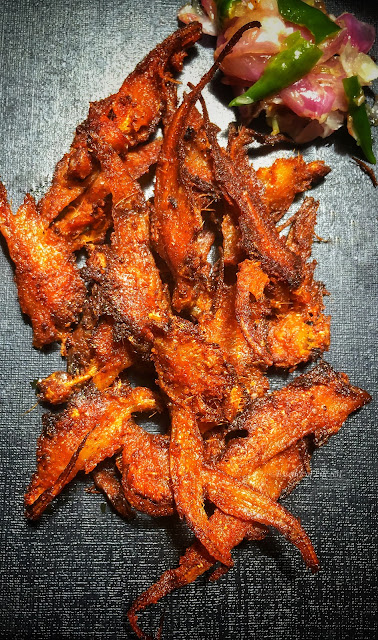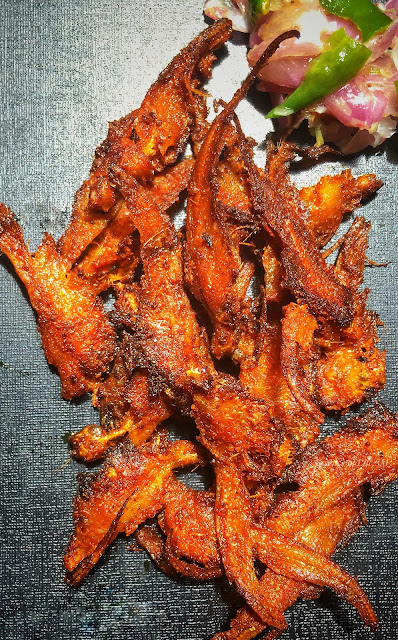 |
Ammamma's Chutney - That Travelled With Me, Stayed With My Amma
You know a recipe is special when it tiptoes into your mom’s kitchen, and then proudly takes centre stage as her signature dish. Ammamma’s Chutney, as lovingly named by my kids, is just that—a humble tomato-onion-coconut chutney I tried out during my college days that now has a legacy of its own in our home.
This isn’t your traditional chutney—it’s my own take on the classic Tamil-style kara chutney, reimagined with a generous scoop of grated coconut, a hint of tamarind, and a handful of fresh herbs for that extra hug of comfort. It’s authentically Tamil at heart, but with a whisper of Malayalee influence—because honestly, how can a Malayalee make chutney without sneaking in some coconut? The result? Something uniquely mine, stirred with memory, spice, and a little cultural mischief.
It's a simple combination of sautéed onions, the tang of ripe tomatoes, the zing of green chillies, the earthiness of coconut, and that little sweet-sour nudge from tamarind—it’s the chutney that turns even a humble dosa into an experience. And if you're, like my daughter who's staying outside from your home, and if you are flipping dosa from a ready made batter, this chutney is your shortcut to homemade comfort.
A couple of days ago, she pinged me up saying, "Ammie, I wanted to make Ammama chutney—and I did not see it in our blog." She’d been browsing the blog and found it lacking in chutney recipes (guilty as charged!). That’s when I knew it was time to bring back this all time go to chutney at home—our beloved family favourite.
Tradition Talks: The Chutney That Found Its Way
I still remember learning it from our lovely neighbour, Shanthi Aunty. Her version was a fiery kara chutney—just onions, garlic, tomatoes, and dry red chillies. It was around the time I started taking over dinner duties at home. My mum ran a tailoring shop in the city, and my dad worked long hours—they’d return only after 10 pm. Those late nights became my training ground.
And over the years, I gave Shanthi Aunty’s chutney my own twist—swapping dry chillies for fresh green ones, adding coconut for that creamy touch, a bit of tamarind to round off the flavours, and of course, those greens I can never resist. Mint or coriander—whatever caught my fancy (or what the fridge offered). My MIL once joked I shopped like I had cattle to feed, thanks to all the herbs I brought home. Little did she know—those leaves were the heart of my cooking experiments.
What began as a small kitchen experiment eventually became my mum’s staple, and now my children’s favourite. From college trials to family favourite —it’s earned its seat and a sweet nostalgic nook in our hearts with the iconic name for it - Ammamma's Chutney!
Craving more chutney choices? Check the full Chutney Recipes Collection—from quick fixes to nostalgic favourites, there's a spicy spread for every mood and meal!
Onion Tomato Chutney – Recipe Overview
-
Recipe Type: Chutney / Side Dish
-
Cuisine: South Indian (Tamil-style with a Malayalee twist)
-
Yield: About 1 cup of chutney
-
Servings: Serves 3–4
-
Author: SM (Essence of Life – Food)
Time Estimate:
-
Preparation Time: 10 minutes
-
Cooking Time: 10 minutes
Ammamma’s Chutney: Step-by-Step Guide on How to Make Tomato-Onion-Coconut Chutney
 |
Ingredients:
For Tomato Onion Chutney
- 1 tablespoon Vegetable Oil
- 1 tablespoon Bengal Gram Dal (chana dal)
- 4–5 Green Chillies, slit
- 2 large Onions, chopped
- 2 medium Tomatoes, chopped
- 1 small piece of Ginger or 2 cloves of Garlic
- 1 teaspoon Tamarind Paste
- ½ cup grated Coconut
- A handful of Coriander Leaves or Mint Leaves (or both)
- Salt, to taste
- A pinch of Sugar
Tempering (Optional):
- 1 teaspoon Oil
- ½ teaspoon Mustard Seeds
- 1 teaspoon Chana Dal or Urad Dal
- 1 Dry Red Chilli, broken
- Few Curry Leaves
Method: Step-by-Step Cooking Instructions
Sauté the Base
- Heat oil in a pan. Add Bengal gram dal and roast on low flame until golden. Then toss in the slit green chillies.
ProTip: Always slit your green chillies before sautéing. Whole chillies tend to burst when they hit hot oil—and trust me, no one wants unexpected pop-ups in the kitchen!
Add the Flavour
- Add chopped onions along with ginger or garlic. Once the onions soften, add tomatoes and salt. Cook till tomatoes turn mushy.
Note: Want that deep, rich flavour? Don’t rush this step. Let the tomatoes break down fully.
Add Coconut
- Stir in the tamarind paste. Add grated coconut and sauté for 3–5 mins on low flame until the raw smell disappears. Toss in the herbs—mint, coriander, or both—and switch off the heat.
ProTip: Go light on the greens if using both; too much and your chutney turns into a green herb paste.
Cool & Grind
- Let the mixture cool down. Add a pinch of sugar and grind everything into a smooth chutney.
Note: The sugar doesn’t make it sweet—it balances the tangy and spicy notes beautifully.
Temper It—or Not (Optional)
- Traditionally, we serve this chutney without tempering. But if you're team "tempering-on-everything", splutter the tempering ingredients in oil and pour over the chutney.
ProTip: If making ahead, skip the tempering until right before serving to keep the flavour fresh.
 |
Serving Suggestions
This chutney is a total crowd-pleaser and pairs beautifully with:
-
Idli – soft pillows meet bold flavours
-
Dosa – crispy edges, spicy-savoury centre
-
Uthappam – thick, fluffy, and made better with this chutney
-
Kuzhi Paniyaram – the perfect dunking partner
-
Chapati – trust me, it’s an unexpected hit!
Craving more ideas? Take a tasty tour through my Idli-Dosa Recipes & Side Dishes Collection—your one-stop spot for all things deliciously South Indian!
Storage Tips
- Keeps well for 2–3 days in the fridge.
- No reheating needed—just scoop and serve.
- Avoid reheating—it changes the silky texture.
❓ FAQ
Q: Can I use dry red chillies instead of green?
A: Absolutely. The OG version used them—it leans more towards kara chutney.
Q: Can I freeze this chutney?
A: Yes, you can! It freezes beautifully. Just thaw it to room temperature—no reheating needed. The texture stays lovely, and it tastes just as comforting.
Q: I don’t have tamarind paste—what else can I use?
A: A small piece of soaked tamarind works just fine. In a pinch, a few drops of lemon juice will do.
Q: Can I skip mint or coriander?
A: Absolutely. The chutney holds its own without them too. But if you have either on hand, even a little can brighten things up.
Q: Can I skip adding coconut in Ammamma’s Chutney?
A: Yes, you can! While coconut adds a creamy, comforting texture and a subtle sweetness, the chutney still works wonderfully without it—just a bit lighter but full of flavour.
 |
Looking for more spicy sidekicks? Here are a few chutney champions you’ll love:
- Milakai Chutney – A fiery onion chutney that’s a quick-fix lifesaver and perfect with dosa or Idli.
- Kongu Thakkali Kuzhambu – A flavour-packed tomato curry-style chutney, straight from the kitchens of our hometown - Coimbatore.
- Getti Chutney (Thick Coconut Chutney) – A beloved classic in every Tamil household, thick, creamy, and most sought after.
- Tomato & Coriander Chutney – Spicy, tangy, and fresh—this chutney is a must-have for your idli-dosa spread.
- Sorakkai Chutney (Bottle Gourd Chutney) – A clever, delicious way to sneak veggies into fussy plates—smooth, subtle, and surprisingly addictive!
Craving more chutney choices? Check the full Chutney Recipes Collection—from quick fixes to nostalgic favourites, there's a spicy spread for every mood and meal!
Have you made Ammamma’s Chutney yet? Whip it up and drop a comment below—what did you pair it with? Tag me if you share it—I’d love to see your twist on it! Let’s keep the memory (and the mint) fresh!




























